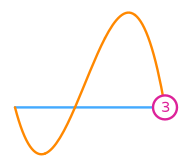an encyclopedia of finite element definitions
Degree 3 serendipity on a interval
◀ Back to serendipity definition page
- \(R\) is the reference interval. The following numbering of the subentities of the reference cell is used:
- \(\mathcal{V}\) is spanned by: \(1\), \(x\), \(x^{2}\), \(x^{3}\)
- \(\mathcal{L}=\{l_0,...,l_{3}\}\)
- Functionals and basis functions:

\(\displaystyle l_{0}:v\mapsto v(0)\)
\(\displaystyle \phi_{0} = - 10 x^{3} + 18 x^{2} - 9 x + 1\)
This DOF is associated with vertex 0 of the reference cell.
\(\displaystyle \phi_{0} = - 10 x^{3} + 18 x^{2} - 9 x + 1\)
This DOF is associated with vertex 0 of the reference cell.
\(\displaystyle l_{1}:v\mapsto v(1)\)
\(\displaystyle \phi_{1} = x \left(10 x^{2} - 12 x + 3\right)\)
This DOF is associated with vertex 1 of the reference cell.
\(\displaystyle \phi_{1} = x \left(10 x^{2} - 12 x + 3\right)\)
This DOF is associated with vertex 1 of the reference cell.
\(\displaystyle l_{2}:v\mapsto\displaystyle\int_{R}(1 - s_{0})v\)
where \(R\) is the reference element;
and \(s_{0}\) is a parametrisation of \(R\).
\(\displaystyle \phi_{2} = 12 x \left(5 x^{2} - 8 x + 3\right)\)
This DOF is associated with edge 0 of the reference cell.
where \(R\) is the reference element;
and \(s_{0}\) is a parametrisation of \(R\).
\(\displaystyle \phi_{2} = 12 x \left(5 x^{2} - 8 x + 3\right)\)
This DOF is associated with edge 0 of the reference cell.



